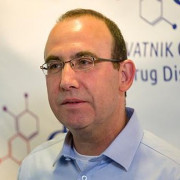Tel-Aviv U. et Weizmann (Israël) : un nanomatériau crée une énergie "verte" pour l'humain et l'environnement

[:fr]
Un nouveau nanomatériau va permettre de produire un courant électrique « sain » à l’intérieur du corps humain. Respectueux de l’environnement, biologique et non toxique, il ne cause aucun dommage aux tissus du corps humain. Aussi solide que le titane et extrêmement flexible, il permettra, entre autres, de charger les stimulateurs cardiaques en utilisant uniquement le rythme cardiaque, éliminant ainsi le besoin de piles. Il permettra aussi de produire de l’énergie verte activée par une force mécanique qui pourra également être appliquée à d’autres domaines, par exemple, une voiture roulant dans la rue pourra allumer les lampadaires.
Une équipe de recherche internationale dirigée par des chercheurs de l’Université de Tel Aviv a mis au point ce nanomatériau qui permettra de générer des courants électriques et des tensions dans le corps humain activés par divers organes (force mécanique). Ce nouveau matériau biologique très résistant, similaire au collagène, est non toxique et ne cause aucun dommage aux tissus du corps.
Les chercheurs pensent que cette nouvelle nanotechnologie a de nombreuses applications potentielles en médecine, notamment la récolte d’énergie propre pour faire fonctionner des dispositifs implantés dans le corps (tels que des stimulateurs cardiaques) grâce aux mouvements naturels du corps, éliminant ainsi le besoin de piles.

Le Pr Ehud Gazit explique : « Le collagène est la protéine la plus répandue dans le corps humain, constituant environ 30% de toutes les protéines de notre corps. C’est un matériau biologique avec une structure hélicoïdale et une variété de propriétés physiques importantes, telles que la résistance mécanique et la flexibilité, qui sont utiles dans de nombreuses applications. Cependant, comme la molécule de collagène elle-même est grande et complexe, les chercheurs recherchent depuis longtemps une molécule minimaliste, courte et simple basée sur le collagène et présentant des propriétés similaires. Il y a environ un an et demi, dans la revue Nature Materials, notre groupe a publié une étude dans laquelle nous avons utilisé des moyens nano-technologiques pour concevoir un nouveau matériau biologique répondant à ces exigences. C’est un tripeptide – une molécule très courte appelée Hyp-Phe-Phe composée de seulement trois acides aminés – capable d’un processus simple d’auto-assemblage pour former une structure hélicoïdale semblable au collagène qui est flexible et possède une résistance similaire à celle du titane. Dans la présente étude, nous avons cherché à examiner si le nouveau matériau que nous avons développé présente une autre caractéristique qui caractérise le collagène : la piézoélectricité ».
Dans l’étude, les chercheurs ont créé des structures nanométriques de ce matériau et, à l’aide d’outils nanotechnologiques avancés, leur ont appliqué une pression mécanique. L’expérience a révélé que le matériau produit effectivement des courants électriques et des tensions en raison de la pression. De plus, de minuscules structures de quelques centaines de nanomètres seulement ont démontré l’un des niveaux les plus élevés de capacité piézoélectrique jamais découvert, comparable ou supérieur à celui des matériaux piézoélectriques courants (dont la plupart contiennent du plomb et ne sont donc pas adaptés aux applications médicales).
Selon les chercheurs, la découverte d’une piézoélectricité de cette ampleur dans un matériau nanométrique est d’une grande importance, car elle démontre la capacité du matériau fabriqué à servir de petit moteur pour de très petits appareils. Par la suite, les chercheurs prévoient d’appliquer des méthodes de cristallographie et de mécanique quantique computationnelle (théorie fonctionnelle de la densité) afin d’acquérir une compréhension approfondie du comportement piézoélectrique du matériau et ainsi permettre l’ingénierie précise des cristaux pour la construction de dispositifs biomédicaux.
Le Pr Gazit ajoute : « La plupart des matériaux piézoélectriques que nous connaissons aujourd’hui sont des matériaux toxiques à base de plomb, ou polymères, ce qui signifie qu’ils ne sont pas respectueux de l’environnement et du corps humain. Cependant, notre nouveau matériau est entièrement biologique et convient donc à une utilisation dans le corps. Par exemple, un appareil fabriqué à partir de ce matériau peut remplacer une batterie qui fournit de l’énergie aux implants comme les stimulateurs cardiaques, qui doivent être remplacés régulièrement. Les mouvements du corps (battements cardiaques, mouvements de la mâchoire, selles ou tout autre mouvement réguliers dans le corps) chargeront l’appareil en électricité, ce qui activera l’implant en continu ».
A présent, les chercheurs cherchent à comprendre les mécanismes moléculaires du matériau modifié dans le but de réaliser son immense potentiel et de transformer cette découverte scientifique en technologie appliquée. À ce stade, l’accent est mis sur le développement de dispositifs médicaux, mais le Pr Gazit souligne que « les matériaux piézoélectriques respectueux de l’environnement, tels que celui que nous avons développé, ont un potentiel énorme dans un large éventail de domaines car ils produisent de l’énergie verte à l’aide de mouvements mécaniques. Par exemple, une voiture roulant dans la rue peut allumer les lampadaires. Ces matériaux peuvent également remplacer les matériaux piézoélectriques contenant du plomb largement utilisés, mais qui soulèvent des inquiétudes quant aux fuites de métaux toxiques dans l’environnement ».
L’étude a été dirigée par le Pr Ehud Gazit de l’École Shmunis de biomédecine et de recherche sur le cancer de la Wise Faculty of Life Sciences (également directeur fondateur du Blavatnik Center for Drug Discovery), le Département des sciences et de l’ingénierie des matériaux de la Fleischman Faculty of Engineering et du Center for Nanoscience and Nanotechnology, avec l’équipe du laboratoire, le Dr Santu Bera et le Dr Wei Ji. Des chercheurs de l’Institut Weizmann et d’autres instituts en Irlande, en Chine et en Australie ont également participé à l’étude. À la suite de leurs découvertes, les chercheurs ont reçu deux subventions ERC-POC visant à utiliser la recherche scientifique de la subvention ERC que Gazit avait précédemment remportée pour la technologie appliquée.
Publication dans Nature Communications 11 mai 2021 et autre en 2019
*La piézoélectricité est la capacité d’un matériau à générer des courants électriques et une tension à la suite de l’application d’une force mécanique, ou vice versa, à créer une force mécanique à la suite d’une exposition à un champ électrique.
Traduit et adapté par Esther Amar pour Israël Science Info
[:en]
A new nanotechnology development by an international research team led by Tel Aviv University researchers will make it possible to generate electric currents and voltage within the human body through the activation of various organs (mechanical force). The researchers explain that the development involves a new and very strong biological material, similar to collagen, which is non-toxic and causes no harm to the body’s tissues. The researchers believe that this new nanotechnology has many potential applications in medicine, including harvesting clean energy to operate devices implanted in the body (such as pacemakers) through the body’s natural movements, eliminating the need for batteries.
The study was led by Prof. Ehud Gazit of the Shmunis School of Biomedicine and Cancer Research at the Wise Faculty of Life Sciences, the Department of Materials Science and Engineering at the Fleischman Faculty of Engineering and the Center for Nanoscience and Nanotechnology, along with his lab team, Dr. Santu Bera and Dr. Wei Ji.
Also taking part in the study were researchers from the Weizmann Institute and a number of research institutes in Ireland, China and Australia. As a result of their findings, the researchers received two ERC-POC grants aimed at using the scientific research from the ERC grant that Gazit had previously won for applied technology.

Prof. Gazit, who is also Founding Director of the BLAVATNIK CENTER for Drug Discovery, explains: “Collagen is the most prevalent protein in the human body, constituting about 30% of all of the proteins in our body. It is a biological material with a helical structure and a variety of important physical properties, such as mechanical strength and flexibility, which are useful in many applications. However, because the collagen molecule itself is large and complex, researchers have long been looking for a minimalistic, short and simple molecule that is based on collagen and exhibits similar properties. About a year and a half ago, in the journal Nature Materials, our group published a study in which we used nanotechnological means to engineer a new biological material that meets these requirements. It is a tripeptide – a very short molecule called Hyp-Phe-Phe consisting of only three amino acids – capable of a simple process of self-assembly of forming a collagen-like helical structure that is flexible and boasts a strength similar to that of the metal titanium. In the present study, we sought to examine whether the new material we developed bears another feature that characterizes collagen – piezoelectricity. Piezoelectricity is the ability of a material to generate electric currents and voltage as a result of the application of mechanical force, or vice versa, to create a mechanical force as the result of exposure to an electric field.”
In the study, the researchers created nanometric structures of the engineered material, and with the help of advanced nanotechnology tools, applied mechanical pressure on them. The experiment revealed that the material does indeed produce electric currents and voltage as a result of the pressure. Moreover, tiny structures of only hundreds of nanometers demonstrated one of the highest levels of piezoelectric ability ever discovered, comparable or superior to that of the piezoelectric materials commonly found in today’s market (most of which contain lead and are therefore not suitable for medical applications).
According to the researchers, the discovery of piezoelectricity of this magnitude in a nanometric material is of great significance, as it demonstrates the ability of the engineered material to serve as a kind of tiny motor for very small devices. Next, the researchers plan to apply crystallography and computational quantum mechanical methods (density functional theory) in order to gain an in-depth understanding of the material’s piezoelectric behavior and thereby enable the accurate engineering of crystals for the building of biomedical devices.
Prof. Gazit adds: “Most of the piezoelectric materials that we know of today are toxic lead-based materials, or polymers, meaning they are not environmentally and human body-friendly. Our new material, however, is completely biological, and therefore suitable for uses within the body. For example, a device made from this material may replace a battery that supplies energy to implants like pacemakers, though it should be replaced from time to time. Body movements – like heartbeats, jaw movements, bowel movements, or any other movement that occurs in the body on a regular basis – will charge the device with electricity, which will continuously activate the implant.”
Now, as part of their continuing research, the researchers are seeking to understand the molecular mechanisms of the engineered material with the goal of realizing its immense potential and turning this scientific discovery into applied technology. At this stage, the focus is on the development of medical devices, but Prof. Gazit emphasizes that “environmentally friendly piezoelectric materials, such as the one we have developed, have tremendous potential in a wide range of areas because they produce green energy using mechanical force that is being used anyway. For example, a car driving down the street can turn on the streetlights. These materials may also replace lead-containing piezoelectric materials that are currently in widespread use, but that raise concerns about the leakage of toxic metal into the environment.”
Published in Nature Communications
[:]







